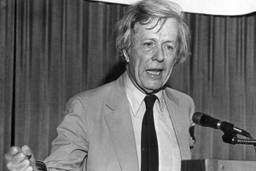
When Robert Skidelsky began his three-volume biography of John Maynard Keynes in the late 70s, it must have seemed a nearly superhuman project, for Keynes was at that time closer to a god than a mortal. Credited with ending the Depression and saving Europe from revolution, Keynes theories were the Bible of the postwar boom.
But now that the last volume, Fighting for Freedom: 1937-1946, is finally done, Keynes bust has been toppled as surely as Lenins. In politics, the New Democrats have proclaimed the era of big government over, doling out tax incentives instead of raising wages. In economics, micro has replaced macro; where Keynes saw the economy in terms of majestic flows of investment and consumption, microeconomists insist that the individual actor, driven by calculated desire, is the sole social force. The onset of Keynes obsolescence might seem to make a new biography less timely. But it seems appropriate, in his case, for the biography to be completed only after the intellectual universe that he helped to create has largely passed away.
Keynes’ life storyas Skidelskys biography makes clearwas that of a man balanced between two worlds. Though he has the reputation of rescuing capitalism from itself, he did so to protect the fragile edifice of high culture from the grimy proles. His economic heterodoxy stemmed from his allegiance to a moral aristocracy. He could save capitalism because he had a certain disdain for the world of business.
Yet the independence that freed Keynes to reconceptualize capitalism also prevented him from fully realizing the political implications of his ideas. I am sure that the power of vested interests is vastly exaggerated compared with the gradual encroachment of ideas, he wrote. From the upper echelons of his esoteric community, he disdained working-class politics; he thought any resistance to his theories was simply a question of the other fellows stupidity.
The political aloofness that liberated Keynes intellectually made it hard for him to be fully aware of the political context that was needed to transform his theories into policies. During the Keynesian postwar boom, unemployment fell to nearly 1 percent in Britain, and economic inequality actually decreased for the only time in the 20th century. This was possible, however, only because of the political birth of labor, in both the United States and Britain, during the Depression and the struggle against fascism in World War II.
Even though Keynes adopted the stance of the brash iconoclast, and his followers tried to squash his ideas into technocratic liberalism, there was a politics to the Keynesian program. In the last volume of this magisterial biography, Skidelsky, himself a British economist, falls into the same trap that Keynes did: He glosses over the political conditions that made it possible for Keynes liberal economic ideas to come to power in the first place.
————–
When John Maynard Keynes was 5 years old, his great-grandmother wrote to him, You will be expected to be very clever, having lived always in Cambridge. Maynard did not disappoint. His father, John Neville Keynes, was a don of moral philosophy who suffered from regular bouts of nervous depression, accumulated endless hobbies to make up for his difficulties doing sustained work, and took an intense pleasure in his eldest sons precocity. Maynard went to Eton and Cambridge, achieved top marks in everything, and joined the Apostles, a secret intellectual society for the pursuit of truth with absolute devotion … by a group of intimate friends (to quote one of its members).
While some might have chafed under such parental adoration, or come to find the gothic spires of the university oppressive, Keynesunlike his fathernever felt himself to be essentially at odds with his surroundings. Despair and alienation would be strangers to him throughout his life. On his deathbed, asked what his greatest regret might be, Keynes is supposed to have replied, I should have drunk more champagne.
It was at Cambridge that Keynes discovered the neo-Platonic philosophy of G.E. Moore, one of his major intellectual influences. The young Moorite circle that gathered at fin-de-siécle Cambridge believed that nothing mattered except states of mind … chiefly our own, as Keynes would write later in life. Passionate contemplation and communionpreferably of art or, better yet, lovewas the highest good in life, over money, ambition or politics. An agnostics substitute for Christianity, Moores philosophy offered the basis for the pursuit of a life outside of the business circles of the belle époque. Life, the young men believed, should be devoted to truth, friendship and love (and not only PlatonicallyKeynes and his male circle were constantly having affairs with one another), a world far removed from the phenomenal one of wealth and power. After Cambridge, Keynes joined the snobbishly bohemian Bloomsbury Group, whose rejection of Victorian values and pursuit of cultural and sexual radicalism suited him well.
Neo-Platonism may seem a strange creed for a practitioner of the dismal science. But Keynes egoistic idealism taught him to value sublime experience, to see all of life as a pursuit of beauty. He once described his young set as immoralists, saying that they did not think they needed to be bound by any rules. This ethos was not rooted in a blueblood background, but its attitude toward rigid Victorian moral codes was one of genteel condescension. When the bourgeois world imploded in World War I and the Great Depression, conservatives responded by clinging all the more desperately to the laissez-faire faith of the 19th century.
Keynes, by contrast, had no political stake in the market mystique, and so was prepared to reject it to save Cambridge from the abyss. (He did gamble the stock market, but mostly as an elegant hobby.) The world he loved was devoted to something other than making money; this freed him to rethink the entire way that capitalism, an economic system driven by the money motive, worked. What bourgeois moralist could have written that the love of money as a possession … is a somewhat disgusting morbidity, one of those semi-criminal, semi-pathological propensities which one hands over with a shudder to the specialists in mental disease? And who but a quasi-aristocrat could have conceived of an economy driven by demand and desire, instead of patient saving?
————–
Keynes wrote The General Theory of Employment, Interest and Money, his greatest book, at the depth of the Great Depression. It was published in 1936, making it all the more amazing that, while mocking and irreverent, The General Theory is an essentially optimistic book about the possibility of reform, the reconcilability of contradictions. The policy argument of The General Theory is that the capitalist economies are driven by consumption, which, in turn, follows from employment. If demand falls to a low level because of mass unemployment, there is no self-correcting market mechanism. It is the responsibility of the state to find a way to make demand rise againif need be, by investing and employing people itself.
But The General Theory also contains a darker vision of capitalism. Keynes painted a picture in which economic well-being rests upon the actions of irresponsible, nearly neurotic individuals. Entrepreneurs vacillate between frenzied excess and anxious withdrawal, taunted by fantasies of triumph and apocalypse. In boom times, their dreams of glory propel them to ever more ephemeral investments. In slumps, they refuse to commit, preferring to clutch at moneys eternal promise of future riches, instead of constructing factories, inventions or skyscrapers.
In proper Bloomsbury fashion, Keynes nudged these stodgy hoarders to flout economic morality, because their jumpy qualms about debt and bankruptcy could lead to disaster. Unlike Marx, Keynes had no interest in production, no real sense about politics and power, no vision of intractable difference or of struggle. For him, the problems of the Depression were melodramatic but hysterical, limited to the surface of events, and so ultimately curable if only people listened to good sense.
There was something evasive about The General Theorys bonhomie (young economists in the 30s referred to the book as a Manifesto of Reason and Cheerfulness). Keynes was always surprised when the implementation of his ideas met with any resistance at all. He did not think he needed to develop a politics appropriate to his worldview; indeed, he sought to distance himself from working-class politics and radicalism. Cambridge and Bloomsbury fed his political conservatism (after Moore, Edmund Burke was his favorite philosopher). Writing against Communism in the mid-20s, he denounced it as a creed which, preferring the mud to the fish, exalts the boorish proletariat above the bourgeois and the intelligentsia who, with whatever faults, are the quality in life and surely carry the seeds of all human advancement.
This conservatism blinded Keynes to the radicalism of his own economics. Even though Keynes was never interested in economic planningindeed, his Middle Way was devised to reduce political pressure for a planned economyhis economic ideas were viewed by many businessmen, in the 30s and later, as highly threatening. The portrayal of businessmen in The General Theory as incompetent and irrational hardly pleased many of them; still less the suggestion that full employment, not high profits, should be the ultimate social goal.
Keynes wrote that The Road to Serfdom, Friedrich Hayeks seminal anti-planning polemic, was a grand book, and that he found himself in deeply moved agreement with nearly the whole book. But this did not spare him the barbs and potshots of market ideologues who saw the expansion of public works, the management of demand and the raising of wages as harbingers of creeping socialism. Other scholars more inclined to the leftlike the Polish economist Michael Kaleckicould see that full employment would create serious political difficulties, since workers are more powerful in a tight labor market. Keynes, because of his hostility to the left, never understood why his economics should meet with hatred from the right.
————–
The last volume of Skidelskys biography covers the late years of Keynes life, after the heart disease that would ultimately kill him at 63 had set in. His declining health is a counterpoint to the deepening global crisis of World War II, and his wartime labors are presented as a heroic race against time, with his ballerina wife, Lydia Lopokova, always at his side. Keynes had been a strategic pacifist for much of the 30s: It is our duty to prolong peace, hour by hour, day by day, for as long as we can. But after the war began, he worked day and night for the British government, helping to devise financing plans for the war, negotiate Lend-Lease with the United States, and create the international financial institutions that would endure into the postwar era. After weeks of grueling work at Bretton Woods, he died in 1946.
Fighting for Freedom is closer to hagiography than the earlier volumes of the biography. Where they do a brilliant job of situating Keynes individual life within his culture and milieu, Fighting for Freedom at times seems like a book about an economic Houdini, single-handedly leading Britain out of one fiscal trap after another. In part, this is because the book catalogues Keynes achievements at the height of his powers and fame. But it is also, paradoxically, because Skidelsky is far more ambivalent about Keynes than he was when he began his biography.
Skidelsky has grown more conservative with the years, even joining the Conservative Party in 1992 (though he has since defected). No longer a believer in the Keynesian analysis, hes left in a strange position when assessing Keynes legacy. As a result, Keynes comes off as an isolated virtuoso in Fighting for Freedom, his accomplishments seeming like nothing more than fluke works of genius. Gone is the sense that they were part of a larger political moment.
One gets the sense that Skidelsky is seeking to reclaim Keynes as the architect of the Third Way, to tailor his ideas and rescue a hero for the era of Blair and Clinton. Skidelsky is careful to note all the ways that Keynes affirmed the verities of classical economics, to observe that Keynes believed investment responds to changes in interest rates, not only demand, and to point out the distance between Keynes and the architects of the British welfare state. This attempt to rescue Keynes for the Third Way (or the Middle Way) is not really successful.
On the one hand, Keynes did not exactly occupy a middle position between the right and the left. Unlike the Third Way today, he did not seek to modify a state sector with injections of the market. He sought, rather, to defend an old world of high culture and leisure from political radicalism and social instability. He wound up instead creating something entirely new. Before Keynes, no one believed that government in a democratic society had a role to play in managing economic growth. After Keynes, this would be one of the hallmarks of democracy.
But in the future, liberal economics will be fought forand wonnot by latter-day gentleman-scholars, but by economists who are able to ally themselves with political forces devoted to equality, stability and securing the good life for all. Or, as Keynes put it, to a world where for the first time since his creation man will be faced with his real, his permanent problemhow to use his freedom from pressing economic cares … to live wisely and agreeably and well.
But now that the last volume, Fighting for Freedom: 1937-1946, is finally done, Keynes bust has been toppled as surely as Lenins. In politics, the New Democrats have proclaimed the era of big government over, doling out tax incentives instead of raising wages. In economics, micro has replaced macro; where Keynes saw the economy in terms of majestic flows of investment and consumption, microeconomists insist that the individual actor, driven by calculated desire, is the sole social force. The onset of Keynes obsolescence might seem to make a new biography less timely. But it seems appropriate, in his case, for the biography to be completed only after the intellectual universe that he helped to create has largely passed away.
Keynes’ life storyas Skidelskys biography makes clearwas that of a man balanced between two worlds. Though he has the reputation of rescuing capitalism from itself, he did so to protect the fragile edifice of high culture from the grimy proles. His economic heterodoxy stemmed from his allegiance to a moral aristocracy. He could save capitalism because he had a certain disdain for the world of business.
Yet the independence that freed Keynes to reconceptualize capitalism also prevented him from fully realizing the political implications of his ideas. I am sure that the power of vested interests is vastly exaggerated compared with the gradual encroachment of ideas, he wrote. From the upper echelons of his esoteric community, he disdained working-class politics; he thought any resistance to his theories was simply a question of the other fellows stupidity.
The political aloofness that liberated Keynes intellectually made it hard for him to be fully aware of the political context that was needed to transform his theories into policies. During the Keynesian postwar boom, unemployment fell to nearly 1 percent in Britain, and economic inequality actually decreased for the only time in the 20th century. This was possible, however, only because of the political birth of labor, in both the United States and Britain, during the Depression and the struggle against fascism in World War II.
Even though Keynes adopted the stance of the brash iconoclast, and his followers tried to squash his ideas into technocratic liberalism, there was a politics to the Keynesian program. In the last volume of this magisterial biography, Skidelsky, himself a British economist, falls into the same trap that Keynes did: He glosses over the political conditions that made it possible for Keynes liberal economic ideas to come to power in the first place.
————–
When John Maynard Keynes was 5 years old, his great-grandmother wrote to him, You will be expected to be very clever, having lived always in Cambridge. Maynard did not disappoint. His father, John Neville Keynes, was a don of moral philosophy who suffered from regular bouts of nervous depression, accumulated endless hobbies to make up for his difficulties doing sustained work, and took an intense pleasure in his eldest sons precocity. Maynard went to Eton and Cambridge, achieved top marks in everything, and joined the Apostles, a secret intellectual society for the pursuit of truth with absolute devotion … by a group of intimate friends (to quote one of its members).
While some might have chafed under such parental adoration, or come to find the gothic spires of the university oppressive, Keynesunlike his fathernever felt himself to be essentially at odds with his surroundings. Despair and alienation would be strangers to him throughout his life. On his deathbed, asked what his greatest regret might be, Keynes is supposed to have replied, I should have drunk more champagne.
It was at Cambridge that Keynes discovered the neo-Platonic philosophy of G.E. Moore, one of his major intellectual influences. The young Moorite circle that gathered at fin-de-siécle Cambridge believed that nothing mattered except states of mind … chiefly our own, as Keynes would write later in life. Passionate contemplation and communionpreferably of art or, better yet, lovewas the highest good in life, over money, ambition or politics. An agnostics substitute for Christianity, Moores philosophy offered the basis for the pursuit of a life outside of the business circles of the belle époque. Life, the young men believed, should be devoted to truth, friendship and love (and not only PlatonicallyKeynes and his male circle were constantly having affairs with one another), a world far removed from the phenomenal one of wealth and power. After Cambridge, Keynes joined the snobbishly bohemian Bloomsbury Group, whose rejection of Victorian values and pursuit of cultural and sexual radicalism suited him well.
Neo-Platonism may seem a strange creed for a practitioner of the dismal science. But Keynes egoistic idealism taught him to value sublime experience, to see all of life as a pursuit of beauty. He once described his young set as immoralists, saying that they did not think they needed to be bound by any rules. This ethos was not rooted in a blueblood background, but its attitude toward rigid Victorian moral codes was one of genteel condescension. When the bourgeois world imploded in World War I and the Great Depression, conservatives responded by clinging all the more desperately to the laissez-faire faith of the 19th century.
Keynes, by contrast, had no political stake in the market mystique, and so was prepared to reject it to save Cambridge from the abyss. (He did gamble the stock market, but mostly as an elegant hobby.) The world he loved was devoted to something other than making money; this freed him to rethink the entire way that capitalism, an economic system driven by the money motive, worked. What bourgeois moralist could have written that the love of money as a possession … is a somewhat disgusting morbidity, one of those semi-criminal, semi-pathological propensities which one hands over with a shudder to the specialists in mental disease? And who but a quasi-aristocrat could have conceived of an economy driven by demand and desire, instead of patient saving?
————–
Keynes wrote The General Theory of Employment, Interest and Money, his greatest book, at the depth of the Great Depression. It was published in 1936, making it all the more amazing that, while mocking and irreverent, The General Theory is an essentially optimistic book about the possibility of reform, the reconcilability of contradictions. The policy argument of The General Theory is that the capitalist economies are driven by consumption, which, in turn, follows from employment. If demand falls to a low level because of mass unemployment, there is no self-correcting market mechanism. It is the responsibility of the state to find a way to make demand rise againif need be, by investing and employing people itself.
But The General Theory also contains a darker vision of capitalism. Keynes painted a picture in which economic well-being rests upon the actions of irresponsible, nearly neurotic individuals. Entrepreneurs vacillate between frenzied excess and anxious withdrawal, taunted by fantasies of triumph and apocalypse. In boom times, their dreams of glory propel them to ever more ephemeral investments. In slumps, they refuse to commit, preferring to clutch at moneys eternal promise of future riches, instead of constructing factories, inventions or skyscrapers.
In proper Bloomsbury fashion, Keynes nudged these stodgy hoarders to flout economic morality, because their jumpy qualms about debt and bankruptcy could lead to disaster. Unlike Marx, Keynes had no interest in production, no real sense about politics and power, no vision of intractable difference or of struggle. For him, the problems of the Depression were melodramatic but hysterical, limited to the surface of events, and so ultimately curable if only people listened to good sense.
There was something evasive about The General Theorys bonhomie (young economists in the 30s referred to the book as a Manifesto of Reason and Cheerfulness). Keynes was always surprised when the implementation of his ideas met with any resistance at all. He did not think he needed to develop a politics appropriate to his worldview; indeed, he sought to distance himself from working-class politics and radicalism. Cambridge and Bloomsbury fed his political conservatism (after Moore, Edmund Burke was his favorite philosopher). Writing against Communism in the mid-20s, he denounced it as a creed which, preferring the mud to the fish, exalts the boorish proletariat above the bourgeois and the intelligentsia who, with whatever faults, are the quality in life and surely carry the seeds of all human advancement.
This conservatism blinded Keynes to the radicalism of his own economics. Even though Keynes was never interested in economic planningindeed, his Middle Way was devised to reduce political pressure for a planned economyhis economic ideas were viewed by many businessmen, in the 30s and later, as highly threatening. The portrayal of businessmen in The General Theory as incompetent and irrational hardly pleased many of them; still less the suggestion that full employment, not high profits, should be the ultimate social goal.
Keynes wrote that The Road to Serfdom, Friedrich Hayeks seminal anti-planning polemic, was a grand book, and that he found himself in deeply moved agreement with nearly the whole book. But this did not spare him the barbs and potshots of market ideologues who saw the expansion of public works, the management of demand and the raising of wages as harbingers of creeping socialism. Other scholars more inclined to the leftlike the Polish economist Michael Kaleckicould see that full employment would create serious political difficulties, since workers are more powerful in a tight labor market. Keynes, because of his hostility to the left, never understood why his economics should meet with hatred from the right.
————–
The last volume of Skidelskys biography covers the late years of Keynes life, after the heart disease that would ultimately kill him at 63 had set in. His declining health is a counterpoint to the deepening global crisis of World War II, and his wartime labors are presented as a heroic race against time, with his ballerina wife, Lydia Lopokova, always at his side. Keynes had been a strategic pacifist for much of the 30s: It is our duty to prolong peace, hour by hour, day by day, for as long as we can. But after the war began, he worked day and night for the British government, helping to devise financing plans for the war, negotiate Lend-Lease with the United States, and create the international financial institutions that would endure into the postwar era. After weeks of grueling work at Bretton Woods, he died in 1946.
Fighting for Freedom is closer to hagiography than the earlier volumes of the biography. Where they do a brilliant job of situating Keynes individual life within his culture and milieu, Fighting for Freedom at times seems like a book about an economic Houdini, single-handedly leading Britain out of one fiscal trap after another. In part, this is because the book catalogues Keynes achievements at the height of his powers and fame. But it is also, paradoxically, because Skidelsky is far more ambivalent about Keynes than he was when he began his biography.
Skidelsky has grown more conservative with the years, even joining the Conservative Party in 1992 (though he has since defected). No longer a believer in the Keynesian analysis, hes left in a strange position when assessing Keynes legacy. As a result, Keynes comes off as an isolated virtuoso in Fighting for Freedom, his accomplishments seeming like nothing more than fluke works of genius. Gone is the sense that they were part of a larger political moment.
One gets the sense that Skidelsky is seeking to reclaim Keynes as the architect of the Third Way, to tailor his ideas and rescue a hero for the era of Blair and Clinton. Skidelsky is careful to note all the ways that Keynes affirmed the verities of classical economics, to observe that Keynes believed investment responds to changes in interest rates, not only demand, and to point out the distance between Keynes and the architects of the British welfare state. This attempt to rescue Keynes for the Third Way (or the Middle Way) is not really successful.
On the one hand, Keynes did not exactly occupy a middle position between the right and the left. Unlike the Third Way today, he did not seek to modify a state sector with injections of the market. He sought, rather, to defend an old world of high culture and leisure from political radicalism and social instability. He wound up instead creating something entirely new. Before Keynes, no one believed that government in a democratic society had a role to play in managing economic growth. After Keynes, this would be one of the hallmarks of democracy.
But in the future, liberal economics will be fought forand wonnot by latter-day gentleman-scholars, but by economists who are able to ally themselves with political forces devoted to equality, stability and securing the good life for all. Or, as Keynes put it, to a world where for the first time since his creation man will be faced with his real, his permanent problemhow to use his freedom from pressing economic cares … to live wisely and agreeably and well.
Please consider supporting our work.

I hope you found this article important. Before you leave, I want to ask you to consider supporting our work with a donation. In These Times needs readers like you to help sustain our mission. We don’t depend on—or want—corporate advertising or deep-pocketed billionaires to fund our journalism. We’re supported by you, the reader, so we can focus on covering the issues that matter most to the progressive movement without fear or compromise.
Our work isn’t hidden behind a paywall because of people like you who support our journalism. We want to keep it that way. If you value the work we do and the movements we cover, please consider donating to In These Times.
Kim Phillips-Fein is a writer in New York City and a contributing editor to In These Times. She is working on a book about the business backlash against the New Deal.







